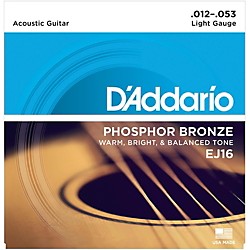April 09, 2015
Changing Guitar Strings: Knowing When and How Often


Did you know the only time some guitarists change their guitar strings is when they break one? Although this is a common string-changing scenario, it doesn’t mean it’s the right choice for everyone. While some guitarists think you shouldn’t go through the effort of changing guitar strings unless they’re broken, it comes down to this: if your strings are old, your guitar is not in perfect working order. Obviously, if a string breaks on your guitar you’ll need to replace them, but what other signs should you look out for? From rust or discoloration to a dull sound, here are some instances when you should change your guitar strings.


Are Your Strings Rusty or Discolored?
If you can see severe discoloration in the strings or notice rust, it’s only a matter of time until you break a string. Whenever you play, sweat, oil, dirt, and grime accumulate on the strings of your guitar. This accumulation, when combined with everyday wear and tear, corrodes the strings. Those who sweat more than others or who have high levels of acidity in their sweat may have to replace their strings more often than those who sweat less or whose sweat contains less acidity. In addition to being a tell-tale sign that a string is about to break, corroded strings can cut your fingers, especially if you slide often. Even if you rarely play your guitar, even the humidity in the air can cause the strings to corrode.
Does Your Guitar Have Tuning Problems?
If your guitar is properly set up and it won’t stay in tune, your strings may be in need of changing. Although tuning issues shouldn’t always be blamed on the strings and could be related to bad tuners, a warped neck, or an improperly cut nut, older strings don’t hold their tune as well as a set of brand new strings. Since old strings are already stretched, tuning issues typically stem from other factors, including rust, scraped stings, or grooves pitting underneath the string above the fret from an aggressive fretting hand. As you become more comfortable with the guitar and find a type of string you prefer, you’ll be able to tell when your strings are getting old and need a change.
Does Your Guitar Sound Dull?
Did you know dead and dying strings produce a dead and dying sound? For new guitar players, this is often the first sign that something is wrong. If your strings don’t ring as loud or don’t sound as rich, they probably need to be replaced. Additionally, if you know how to do guitar techniques, such as sliding or power chords, and you’re getting a noticeably flat sound whenever you attempt these techniques, it could be the strings. Try applying more pressure, and if the problem persists for more than a couple days after applying more pressure, head to the store and pick up a new set of strings. Not only will a new set of strings brighten up the tone, but they’ll feel smooth and comfortable under your fingers.


When’s the Last Time You Changed Your Strings?
If you can’t remember the last time you replaced your strings, bought or your instrument second-hand with strings already attached, or bought your instrument over a year ago and haven’t yet switched them out, it’s probably time that you do. Over time, strings get worn out and, if you play the guitar frequently enough to be reading this article, you have most likely worn out whichever strings are currently on your guitar. So, if you have the extra cash and your guitar isn’t responding the way you think it should, consider replacing your guitar strings at your earliest convenience.
Note: if you’re buying and replacing strings for the very first time, be sure to have your music teacher show you how to change strings. If you aren’t taking lessons or if your teacher isn’t available, head to a repair shop and ask someone to show you how. It’ll probably cost more than doing it yourself, but their professional advice will be well worth it.
How to Extend the Life of Your Strings
Fortunately, there are a few things you can do to extend the life of your strings. First, make sure to always wash your hands before you play. The oils and dirt on your fingers transfer to the strings when you play and can corrode them much faster than if you always played with freshly cleaned hands. Second, carefully wipe down the strings before and after playing with a string treatment that’s designed to prevent corrosion. And last, invest in better quality strings. Although better strings are more expensive, they’ll last much longer and you’ll end up saving time and money in the long run.
Ultimately, there is no replacement schedule that every guitar player should follow. Nobody can tell you when to change your strings, as it’s a decision you’ll learn to make on your own. For more information about guitar strings, check out Nylon vs. Steel Strings: A Comparison and Tips for Toughening Up Your Fingertips.







